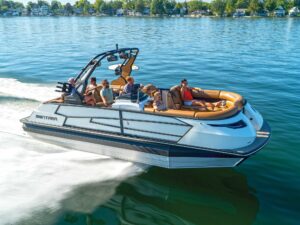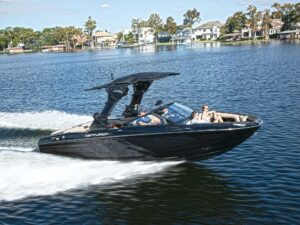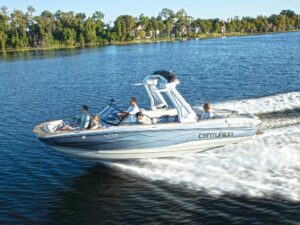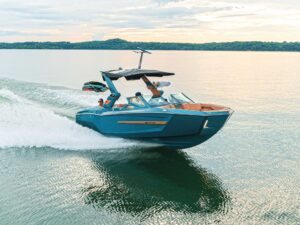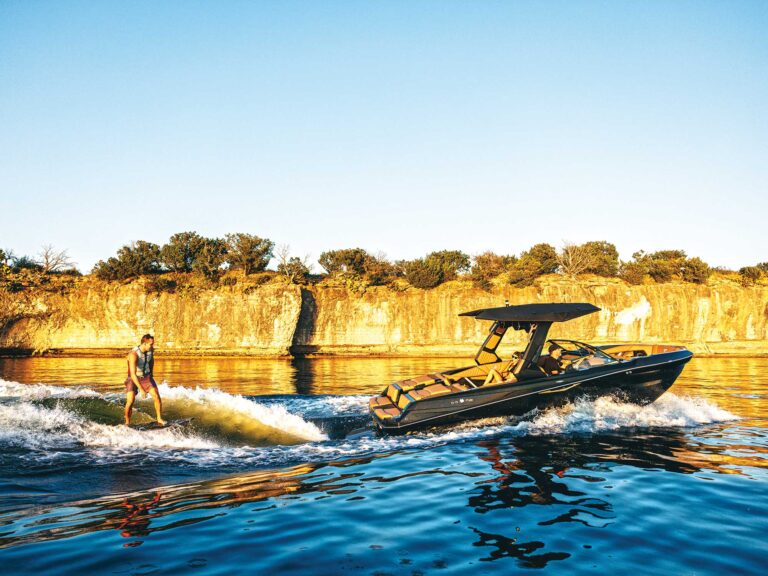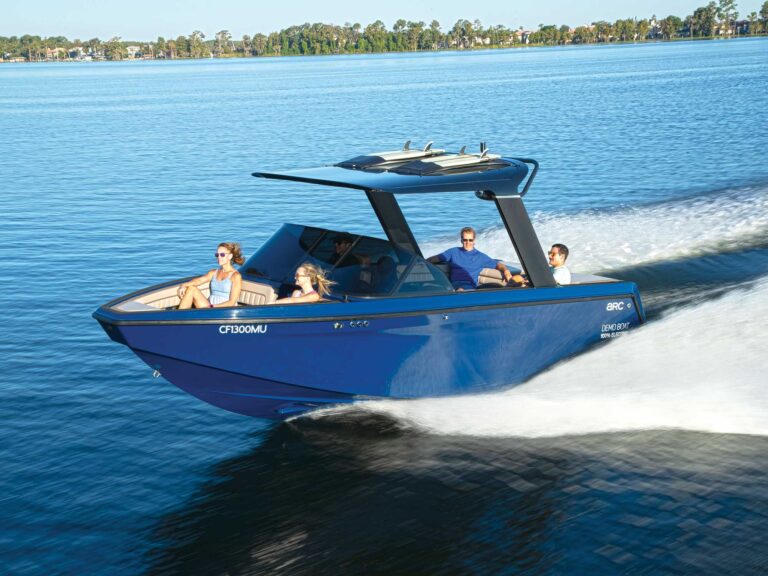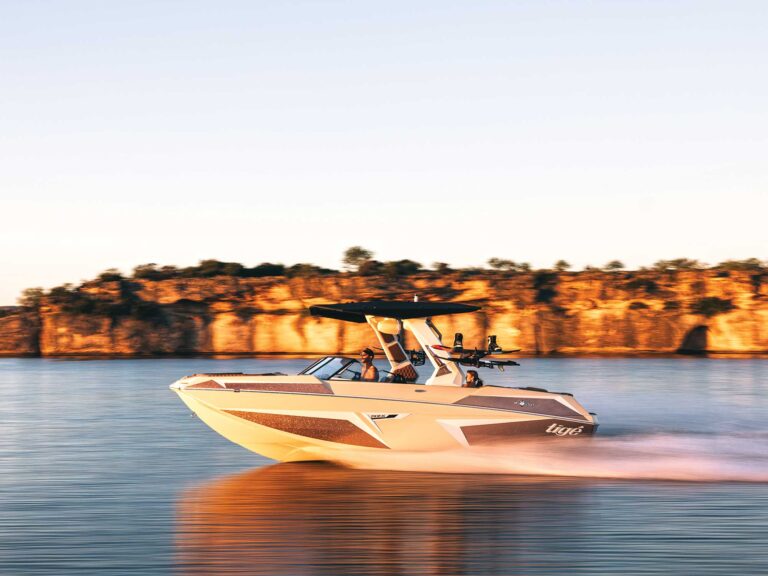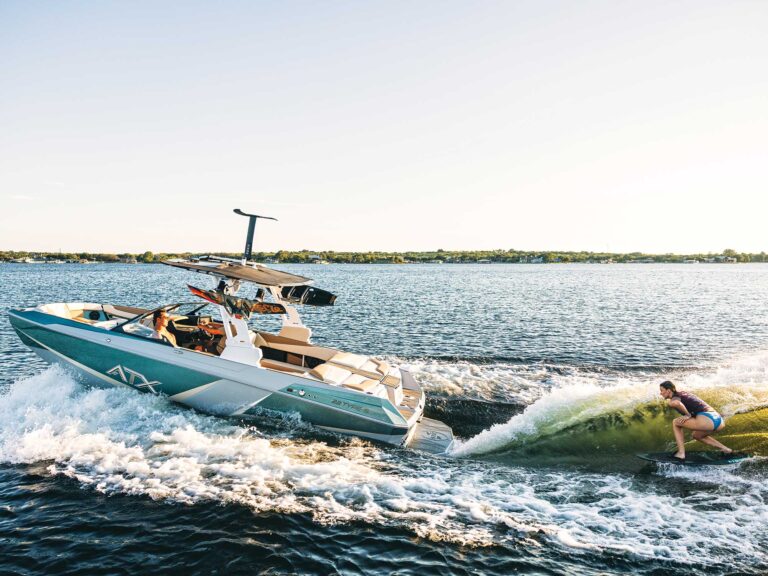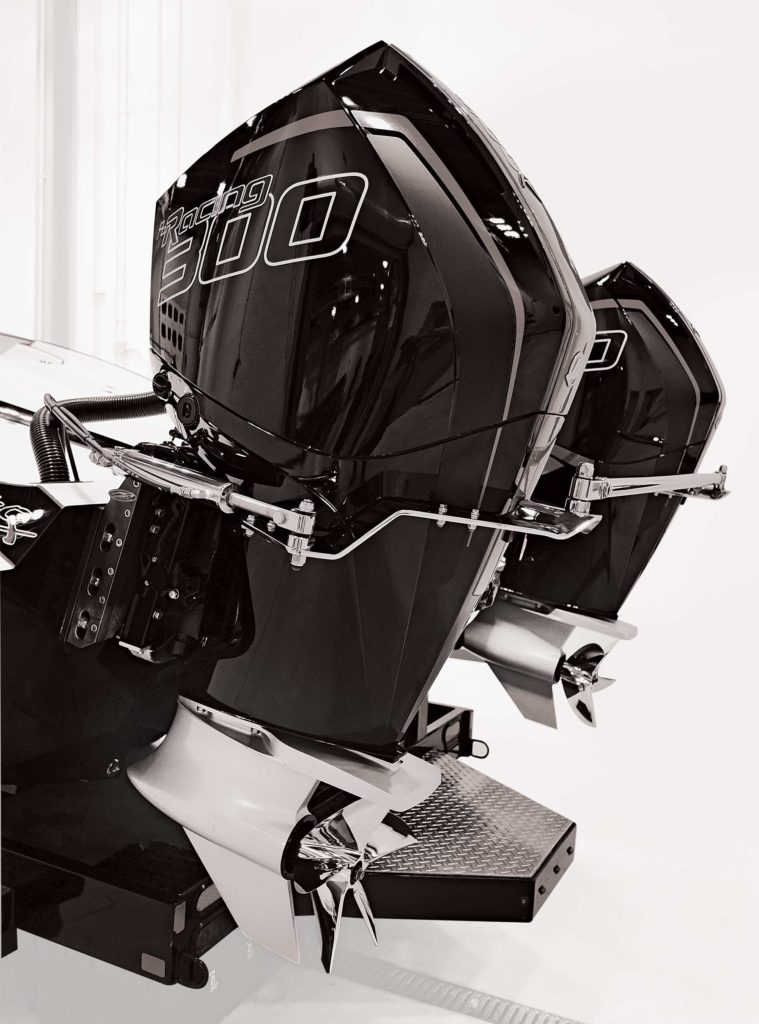
Does your boat lack spirit? Does it feel sluggish or tired? Is it slow to respond to throttle input? Does it suffer from excessive smoking and poor fuel economy? Has your boat become moody and unreliable? Is your outboard faded, its skeg worn and dull? Now there’s a cure. For instantaneous relief, seek an invigorating remedy and simply repower. You don’t need a new boat, just new engines. To learn how, keep reading.
Good Reasons to Repower
At the top of the list: You love your boat; and captain, it’s OK to be sentimental. You like the way the boat runs and handles, you’ve got it rigged and accessorized to function well for you, and maybe you’ve just had a lot of fun or adventure in this boat. You’ve got no desire to go bigger or smaller. If it has been well cared for, a quality boat will almost always outlast its engines, especially in salt water. One dealer told me he thinks the best boats made today will outlast the owner.
Here are some other reasons to repower.
Serviceability: For a variety of reasons, many authorized dealers in saltwater markets just won’t perform service on motors more than 10 years old, and we spoke to one freshwater dealer in Wisconsin who turns away motors made before 1995. Technicians are not familiar with old motors, it can be hard to source parts, and older motors may be so unreliable that it’s hard to keep customers happy.
New Technology: Digital controls, power steering, digital instrumentation and data displays, auto trim—all the cool stuff that wasn’t available when your old motor was built—can make your experience more enjoyable and your boat feel like new.
Better Economy: If you are still running carbureted or EFI two-stroke outboards, expect to get a 25 to 30 percent improvement in fuel economy—and range—by updating to new outboards. New motors are likely quieter and cleaner too.
New Boats Are Expensive: “Sticker shock is a key reason many boat owners decide to repower,” says Karl Neiger, outboard sales manager at Central Marine Service in St. Petersburg, Florida. “The motors get tired, and they find out that a new boat will cost three times what they paid for their current boat when it was new 10 years ago,” says Neiger, who manages 200 to 300 repower projects a year. “All of a sudden, a repower seems like a better idea. I also repower boats for customers who want to sell the boat. If it’s a desirable boat with a tired motor, investing $20,000 in a repower can add $30,000 to $40,000 to the ultimate value of the boat because now you can sell it with reliable power, plus a warranty on the new motor.”
Reliability: Your current motors are a constant source of service headaches, or have even left you stranded at the dock or on the water. Or you want to avoid these old-age issues in the first place. In Florida, busy repower dealers say many customers swap out outboards every three to five years, or after 1,000 to 1,500 hours of use.

Is My Boat a Repower Candidate?
Ideally, the cost to repower should not exceed the ultimate value of the boat, unless you plan to keep it for a long time. Or—and this is OK—you are really sentimental about the boat. The best repower candidates are boats that have been well-maintained, and were quality boats and desirable brands to start with. Don DeMott, Mercury Marine’s business development manager in South Florida, bought a used 2001 28-foot Contender with a single two-stroke Yamaha outboard and repowered a few years ago with a Mercury OptiMax outboard. “I could still get $80,000 for that boat because it’s a great hull and a respected brand,” DeMott says. “Now I could repower with a new Mercury FourStroke that would be even lighter and quieter, and eliminate two-stroke oil and likely add more value.”
In fresh water, engines last longer due to less corrosion and, in colder climates, a shorter season. Warner’s Dock in New Richmond, Wisconsin, does a solid repower business on aluminum fishing boats. “Our repower customer usually has a boat that’s about 10 years old, and he just wants to upgrade to new technology,” third-generation owner Nate Warner says. “Although, it’s common for us to replace 30- and 40-year-old outboards. In this market, repower is cost-effective if the owner is planning to keep the boat for another 10 years. If he thinks he’ll sell it soon, he won’t recoup the repower cost; up here, repower adds value to the current owner, not to the next owner.”
In salt and fresh water, on fiberglass and aluminum boats, the most common roadblock to an easy repower is a bad transom—typically, the wood core is waterlogged—and that should be the first point of inspection made by a good repower dealer. “We won’t touch a boat with any flex in the transom,” Neiger says, “but any transom can be repaired. We will farm that out to a shop we work with, but the job can take three weeks and cost $10,000 or more.” Other dealers cited a lower cost; in fact, Editor-in-Chief Kevin Falvey has been involved with several rebuilt transom jobs that cost about $5,000 each. In all cases, it really depends on the boat.
Can Any Dealer Repower My Boat?
Only a dealer that is authorized to sell a “loose” engine—that’s a new engine in a box from the factory—can do a repower job. Many dealers are only authorized to sell boats that are rigged by the boatbuilder. To get to the next level, the dealer is required to invest in more tech training specific to installing the motors, and to commit to buying a minimum quantity of engines.
When considering a dealer for a repower project, look for a business that is an authorized dealer—the business is listed as a dealer on the engine manufacturer’s website—and one that does a lot of repower work. Ask for references, ask to see technician certification diplomas, and expect to get a detailed estimate for your project, plus a procedure for change orders to handle unanticipated costs that may come up as the work progresses.
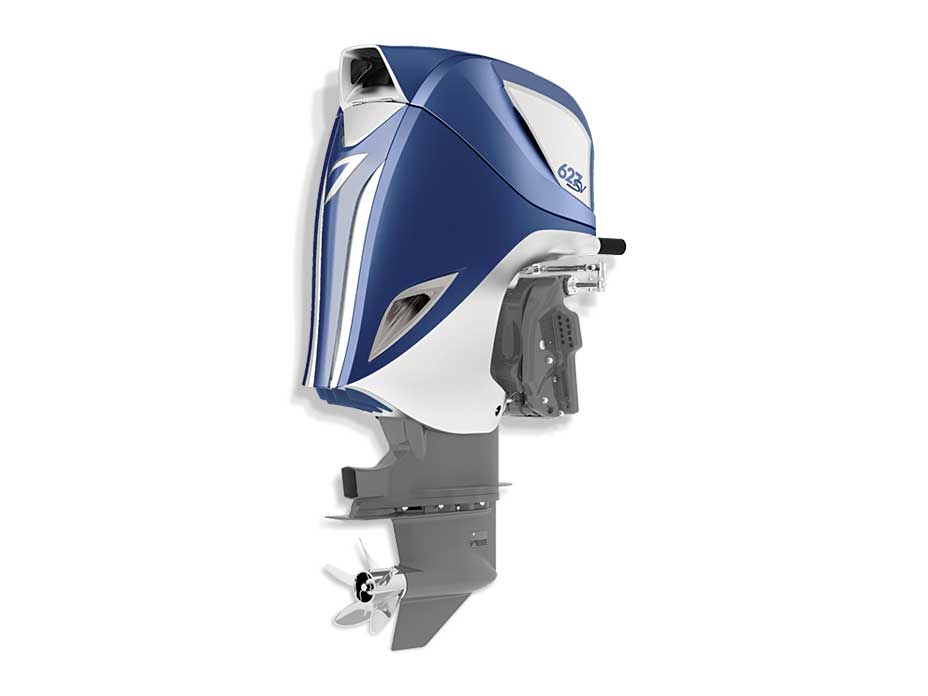
Can I Install More Horsepower?
The answer is yes, but only up to the horsepower limit specified by the boatbuilder when your boat was new. A legitimate dealer will not rig your boat for more horsepower; the liability risk is huge. If your boat does not have a capacity plate, or the plate does not list a horsepower limit, the dealer should not install more than the maximum power the boatbuilder offered on that model when it was new, and a good repower dealer will do that research—again, to avoid any liability issues. If your boat model is still in production and the builder has raised the horsepower limit, say from 600 to 700 horsepower, you cannot move up to the new limit. Again, the standard is the power rating for your boat when it was new.
Can I Convert My Twin-Engine Boat to a Single Engine?
This is a popular repower option, such as replacing twin 200 hp outboards with a single 300 or 350, a motor that may not have been available when the boat was new. It’s a move that will usually make the boat lighter and more fuel-efficient. It will require some transom work because the mounting holes for the twin motors will need to be filled and glassed over, a job that may cost $1,000 to $1,200. This installation will usually also require a new control for the single engine. Transom work like this may also be required when upgrading multiengine installations if the mounting center distance changes. For example, older Yamaha outboards are mounted on 25-inch centers, but the newest Yamahas require 28.5-inch centers. This will also require filling the old mounting holes and drilling new holes in the transom.
Can I Switch Outboard Brands?
Switching brands is usually not a problem. Mastry Repower Centers repowers more than 1,000 boats a year from 10 Florida locations with Suzuki outboards, and most of those boats were powered by another motor brand when new. All outboards have the same – bolt-hole pattern, so unless there’s an issue with engine spacing, hanging the motors is not an issue. You may need to install new controls and instruments, but that’s not always a bad idea anyway.
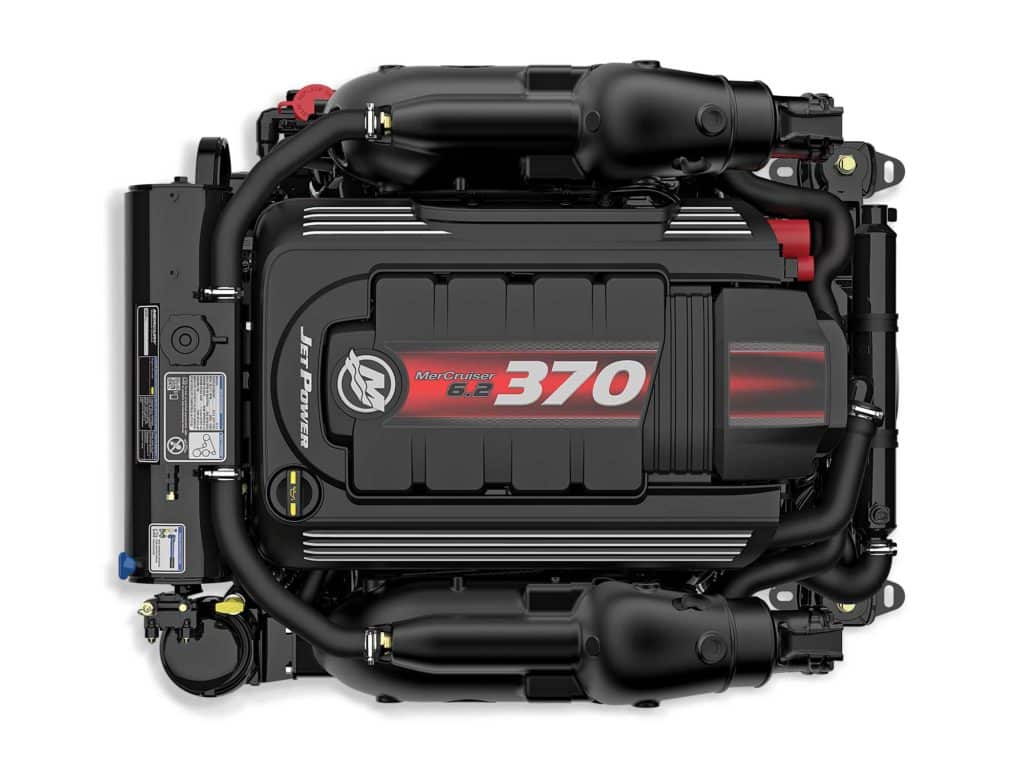
Can I Repower My Sterndrive or Inboard?
Of course. Almost any boat can be repowered, although it’s much more common to repower an outboard-powered boat because those boats typically rack up more hours of use in salt water. Our friend Dan “the Outboard Man” Jansen is very happy with a solid 1983 Cruisers 222 Baron he picked up for $2,500 and repowered with a MerCruiser 6.2L with a Bravo One drive and digital controls, a project he estimates would have a retail cost of about $35,000; he didn’t charge himself for labor.
“The sterndrives we replace typically have a ruined engine,” Jansen says. “Not worn out, but ruined because the owner never checked the oil. Because they can’t see the sterndrive engine like you see an outboard, and because they never check the oil in their car either.”
In Jansen’s shop, a blown sterndrive engine is often replaced with a long block from Mercury Remanufacturing, which is completed with the intake, exhaust and other components from the original engine, if they are usable. Jansen says it’s also easy to upgrade from a carburetor to an easy-starting EFI sterndrive or inboard with a complete engine from Mercury Remanufacturing that is not required to have exhaust catalysts because it’s technically not a new motor.
Replacing a sterndrive or inboard engine will almost always require more labor cost than swapping outboards; some engines are pretty easy to remove, while others can be a big project.
“Last year, we had to cut out part of the deck to remove the engine from one boat,” Jansen says, “so there was fiberglass work added to the cost. But the owner loved his boat.”

Can I Use My Old Controls and Instruments?
The answer is maybe. If your boat is currently all analog—a pre-digital engine, cable controls and analog instruments—a new motor may not be compatible with those controls and instruments. Some of the newest outboards are digital-only, while others can be used with digital or mechanical (aka cable) controls. Yamaha, for example, has made a point of making some of its V-6 outboards available for mechanical controls specifically for repower applications. The new 1.9-liter Evinrude models are digital but can use cable controls with an accessory converter. In the Mercury line, all Verado models require digital controls, but the new FourStroke V-6 and V-8 models can be rigged with digital or mechanical controls. Instrument compatibility gets more complicated because it can depend on whether your boat is currently rigged with gauges that match the engine brand, or those from another supplier. Repower dealers we talked to suggest that analog controls that are less than five years old are usually still functional and don’t need to be replaced. Unless it’s been abused, a digital control won’t wear out, but a newer version might offer more features.
“I remind repower customers that controls and instruments are their touchpoints on the boat,” DeMott says. “You might feel good about saving some money by keeping the old control and instruments, so now you’ve got new power, but you are looking at old gauges and swinging an old control, and you are going to wish it was all new. And a digital control and power steering are really nice upgrades that don’t add a lot to the total cost of a repower project.”
Can I Upgrade to Joystick Controls?
Adding a joystick control for multi-outboard engines is a huge reason customers want to repower, says Kirk Beattie of Preferred Marine in Pompano Beach, Florida, a Mercury-authorized shop that does 10 repower projects a month. “But no Mercury dealer can install Mercury Joystick Piloting for Outboards,” Beattie says. “That feature can be installed only by a builder on a new boat because the software is specific to each boat model, and techs at the builder have been trained to install it. We can and do install the SeaStar Optimus 360 joystick system for repower customers.” The situation is the same for other engine brands; OEM joystick controls are limited to boatbuilder installations.

Can I Repower On My Own?
Probably not, unless you buy a used motor. An outboard dealer authorized to sell loose engines can only sell that motor installed on a boat, unless it’s a portable outboard with screw clamps designed to be removed from the boat. It’s all about liability. After installation, the dealer has to file the warranty paperwork and complete a pre-delivery routine. That dealership is ultimately responsible for every engine it sells.
How Am I Going to Pay for This?
All of the marine engine manufacturers offer financing options for loose engines purchased for repower applications. Suzuki, Honda and Mercury have financing info on their websites. Evinrude and Yamaha want you to speak to the dealer. For example, the Mercury program will finance $5,000 to $50,000 with 10 percent down, and will cover engines, rigging, gauges, controls and labor, which is enough to pay for a single- or twin-engine project. Beyond that, you are probably on your own because lending institutions that make boat loans typically will not make a loan to repower a boat.
What About Hidden Costs?
Surprise costs should be unusual if you are working with a dealer that specializes in repower projects. An outfit such as Mastry Repower has three base packages: 1) Suzuki to Suzuki; 2) Other Brand to Suzuki, with new controls, instruments and wiring harness; and 3) Older Boat, which adds new steering, battery switches and other details. All come with an estimate and a guaranteed price. Central Marine Service typically starts with a baseline estimate from a phone call or email, and then does a thorough inspection and final estimate when the boat is on-site. Because it repowers so many boats, Central Marine can create accurate estimates based on its experience, and it also dials in propping of every boat in fresh water and supplies a performance report.
Read Next: Repowering Your Boat
That said, things can pop up, especially on older boats:
• Water intrusion in the transom or stringers can require expensive repairs.
• The wiring harness or battery cables may be worn or not compatible with the new motor. On an older boat, it’s just smart to replace these items.
• Old instrumentation may not work with a new motor.
• Old controls may not work with a new engine.
• If steering components are worn or just old, it’s smart to replace them with new parts.
• The same goes for fuel lines and filters—it’s smart to replace parts more than five years old.
• You will almost certainly need new props.

